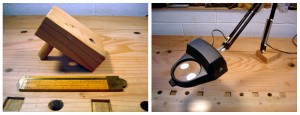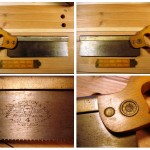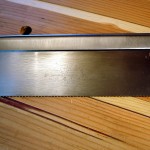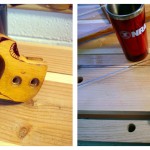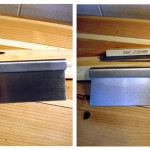The eBay seller warned that hand saws were not part of her expertise. So, I didn’t ask for details. The photos were good enough to think it worth bidding.
Richardson, later Richardson Brothers, was a saw manufacturer in Newark New Jersey, about 20 miles down the road from where we live. From what I’ve learned, Richardson made highly respected products. They had one of the early patents for taper grinds on full length saws. Long story short, it seems they were also a very strong competitor to Disston. One contention is that around 1890 Disston manged to “do away” with some of its competitors by buying them and throwing them into a conglomerate known as “National Saw” which died in 1906.
This particular saw has a medallion that carries the 1867 patent indication placing it later than that date, and before the company started marking their products with a “Richardson Brothers” brand in the late 1870s. The stamping on the spine is an arched “Richardson” with “Newark NJ” below the arch, “Cast Steel” to the left, and “Warranted” to the right. The blade measures 14 inches long and has a depth under the back of 3 and 3/8 inches. It is 0.029″ thick.
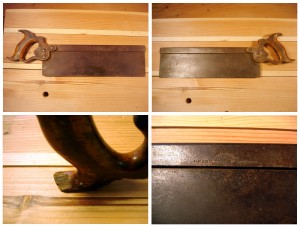 This saw did not lead as sheltered a life as the Disston #4 I restored a couple of weeks ago. Whoever owned this Richardson used it hard, probably never sharpened it, and then left it where it gathered a good bit of rust and pitting and lost most of the finish on the handle. The area of the handle where one grips still had a little varnish and several kinds of “donor paint.” The end where it meets the plate was bare, dry, and heavily stained. The upper horn has a bit split off the underside and presents a ragged edge to the web of the hand that holds it. The plate has no dents and is absolutely straight, as is the spine. It was filed 12 TPI, rip, and arrived in my hands with absolutely no set.
This saw did not lead as sheltered a life as the Disston #4 I restored a couple of weeks ago. Whoever owned this Richardson used it hard, probably never sharpened it, and then left it where it gathered a good bit of rust and pitting and lost most of the finish on the handle. The area of the handle where one grips still had a little varnish and several kinds of “donor paint.” The end where it meets the plate was bare, dry, and heavily stained. The upper horn has a bit split off the underside and presents a ragged edge to the web of the hand that holds it. The plate has no dents and is absolutely straight, as is the spine. It was filed 12 TPI, rip, and arrived in my hands with absolutely no set.
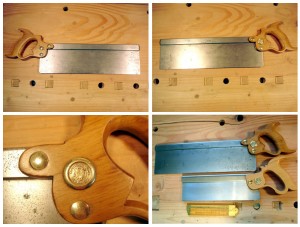 I restored this blade the same way I did the Disston, with a (very long) bath in Evapo-Rust and then lots and lots of sanding. There is still a good bit of pitting and maybe a long session with a belt sander could solve that, but my belt sander has yet to be purchased. I sanded off what little finish remained on the handle and sanded some of the stains away. There’s no need to reshape this handle because it was already of the era when they made them nice and comfortable. As for the split out area on the upper horn, I voted against splicing in a repair and simply carved that area to a new smooth profile. I’m unsure, but think the handle material to be apple which was very prevalent at the time. Finish is 3 coats of clear shellac ending with wax rubbed in with steel wool.
I restored this blade the same way I did the Disston, with a (very long) bath in Evapo-Rust and then lots and lots of sanding. There is still a good bit of pitting and maybe a long session with a belt sander could solve that, but my belt sander has yet to be purchased. I sanded off what little finish remained on the handle and sanded some of the stains away. There’s no need to reshape this handle because it was already of the era when they made them nice and comfortable. As for the split out area on the upper horn, I voted against splicing in a repair and simply carved that area to a new smooth profile. I’m unsure, but think the handle material to be apple which was very prevalent at the time. Finish is 3 coats of clear shellac ending with wax rubbed in with steel wool.
My sharpening required reducing the teeth down to about 50% of their original height before I got a nice row of flat spots to work from. Then I sharpened the toe end with relaxed rake for a couple of inches with the rest sharpened at near zero rake, all on the original 12 TPI. I now have two very nice back saws and might opt for a third for smaller dovetail work.
